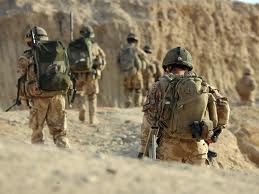Apr
24
LIVING INSIDE OURSELVES
Filed Under Combat PTSD, Life, Peace, PTSD, Tears of a Warrior, Trauma, Treating PTSD, Veterans | Comments Off on LIVING INSIDE OURSELVES
by Janet J. Seahorn, Ph.D

We reside within our own wondrous environment, within ourselves, and wander about the internal hills and valleys everyday. If we are lucky and have lived a full life, the landscape of our inner country is filled with incredible diversity.
Mountains and valleys only have depth based on the extent of our experiences. The brilliant hues of colors cannot be painted on an empty canvas. Nope, such vividness is achieved through a great many life events: joy, grief, humility, arrogance, chaos, serenity… all mixed throughout the years.
Yet, through all our trials and triumphs, with a bit of luck, our inner artist refuses to put down the paintbrush. Each day offers elements to add to the internal country; an element that increases the vastness of the spirit. Within ourselves we wander with purpose and courage. Trauma takes a toll which only hope can overcome.
We become our best selves not because we lived a safe, comfortable life, but because we have fully lived. There is a huge difference between a life of ease and one of worth. The first took little effort; the latter required a deep sense of duty, sacrifice, relentless perseverance, and sometimes tears. All of these make a life of worth a special gift to the world. A gift that lives far beyond our short existence.
Which life have your lived so far. Which life are you living now? What would your canvas look like? Certainly, like any remarkable work of art, it would have its dark contrasts; yet, I hope it would also contain sweeps of light, touches of brilliant colors, and areas of tender hues which embrace a sense of peace and serenity.
Apr
19
THE POWER OF ONE
Filed Under Combat PTSD, Tears of a Warrior, War | Comments Off on THE POWER OF ONE
by Janet J. Seahorn, Ph.D

The title is not totally mine. It was taken from the book which tells the story about the life of a young boy’s quest to become a champion boxer. The journey is one of trauma, discrimination, and blessings. Its moral defines the force of relentless belief in a goal; a goal that impacts not merely the individual, but the larger world. Such ambition would require determination, persistence, courage, goodness, and an immense sense of faith even when walking through absolute darkness.
The Power of One refers to the mind which is the real athlete who primes the body to perform. It is the mind which keeps the individual stable as life becomes fragile. Like walking a tight rope over a raging river gorge, the mind works to convince the body that it is safe even when every nerve cell signals, “You must be kidding”. If you think about what is below the wire your focus will be on falling not on moving forward. So many disturbances fight to invade your concentration, and this is a most dangerous part of trauma… when you lose sight of what you want in your life and accept what you don’t want.
Trauma has its own unique composition. That structure, like any challenging illness, can be incredibly complex. It takes the whole of the person to succeed when all you want to do is give in and give up. The numerous types of events that can cause trauma, the support one receives after the event(s), the person’s internal strength and optimism, all contribute to the trauma’s set of symptoms. No two people’s puzzles are identical, because no two lives are exactly the same.
For every vet and his/her extended family, healing and moving forward will certainly take the Power of One, and that One is YOU! Trust in you own untried capacity (Ella Wilcox). Every day believe YOU are strong enough to make this journey, humble enough to seek help when needed, and gritty enough to succeed.
Apr
14
WHEN STATISTICS ARE WRONG
Filed Under Tears of a Warrior, Vietnam Today | Comments Off on WHEN STATISTICS ARE WRONG
by Janet J. Seahorn, Ph.D

Ok, I’ve been duped and I am not too happy about it. Several of what I thought were reputable websites have been taunting for years that only about 1/3 (850,000) Vietnam veterans were still living. I must it admit it was an unbelievable number which is why I checked it out with other sites to confirm. Turns out all of these sites were wrong, DEAD WRONG!
This weekend Tony and I received his Vietnam Veteran’s of American magazine (March/April 2011). In an article, Not Dead Yet: Mortality Rates Among Vietnam Veterans, Patrick Brady explains where the misleading statistic originated and what the real numbers are… as far as anyone can estimate. It seems the polluted numbers came from a nine-minute video originally posted on YouTube by a group called Veterans Appreciation Alliance. What makes this even crappier is the group was “seeking sponsors and contributions for its Grateful Red, White, & Blue Appreciation Tour” (Brady, p. 29 March/April 2011). This is a pretty despicable way to prey on the hearts and minds of patriotic Americans and makes me even more annoyed. The group’s various websites (yep, they had more than one to capture audiences for their fund rising), even used the Naval Health Research Center as one of its resources. The Center was totally unaware of what was occurring. By the way this particular source was one reason I thought the data was accurate.
So where did this MYTH first originate; according to Brady it came from a phony website, The American War Museum, which seem to disseminate “much false information for reasons only its originator might know” (VVA, March/April 2011). A different site, The American War Library, appears to be run by another one man operation in California by the name of Phillip R.Coleman. Looks as if Mr. Coleman has over two dozen alias such as Otis Willie and Roger Simpson. Yikes!
Now, for the good news according to the Center for Disease Control: “In-country Vietnam veterans accounted for about a third of all Vietnam-era veterans, and if they were dying only slightly faster than the others (veterans serving in the military but not in Vietnam), then the 800,000 era veterans who died from 1960s through 2000 should have included fewer than 300,000 in-country veterans” (Brady, pp. 29-30, March/April 2011). What this really means is only around 325,000 to 350,000 out of 3,566,000 Vietnam veterans serving in-country have died, versus over 2.5 million. Quite a discrepancy in the number of deaths.
Appears many of us were duped by deceitful websites using fancy patriotic names. Thanks to the excellent article by Mr. Brady, I’ve learned my lesson. I am a little wiser, a bit less trusting, and a lot more aggravated at those who try to capitalize on the goodness of others.

